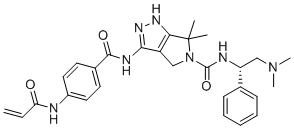YKL-5-124 (YKL-5124) is a novel, selective, and covalent CDK7 inhibitor (IC50=53.5 nM) with anticancer activity. The enzymatic activity of CDK7/CycH/MAT1 is inhibited with an IC50 of 9.7 nM. Additionally, CDK7 exhibits biochemical and cellular selectivity over structurally related kinases CDK12/13.
Physicochemical Properties
| Molecular Formula | C28H33N7O3 |
| Molecular Weight | 515.6067 |
| Exact Mass | 515.264 |
| Elemental Analysis | C, 65.22; H, 6.45; N, 19.02; O, 9.31 |
| CAS # | 1957203-01-8 |
| Related CAS # | YKL-5-124 TFA;2748220-93-9 |
| PubChem CID | 121443990 |
| Appearance | White to off-white solid powder |
| LogP | 2 |
| Hydrogen Bond Donor Count | 4 |
| Hydrogen Bond Acceptor Count | 5 |
| Rotatable Bond Count | 8 |
| Heavy Atom Count | 38 |
| Complexity | 865 |
| Defined Atom Stereocenter Count | 1 |
| SMILES | CC1(C2=C(CN1C(=O)N[C@H](CN(C)C)C3=CC=CC=C3)C(=NN2)NC(=O)C4=CC=C(C=C4)NC(=O)C=C)C |
| InChi Key | KPABJHHKKJIDGX-JOCHJYFZSA-N |
| InChi Code | InChI=1S/C28H33N7O3/c1-6-23(36)29-20-14-12-19(13-15-20)26(37)31-25-21-16-35(28(2,3)24(21)32-33-25)27(38)30-22(17-34(4)5)18-10-8-7-9-11-18/h6-15,22H,1,16-17H2,2-5H3,(H,29,36)(H,30,38)(H2,31,32,33,37)/t22-/m1/s1 |
| Chemical Name | N-[(1S)-2-(dimethylamino)-1-phenylethyl]-6,6-dimethyl-3-[[4-(prop-2-enoylamino)benzoyl]amino]-1,4-dihydropyrrolo[3,4-c]pyrazole-5-carboxamide |
| Synonyms | YKL5-124; YKL-5124; YKL-5 124; YKL-5-124; YKL 5-124 |
| HS Tariff Code | 2934.99.9001 |
| Storage |
Powder-20°C 3 years 4°C 2 years In solvent -80°C 6 months -20°C 1 month |
| Shipping Condition | Room temperature (This product is stable at ambient temperature for a few days during ordinary shipping and time spent in Customs) |
Biological Activity
| Targets | CDK7 (IC50 = 53.5 nM); CDK7/Mat1/CycH (IC50 = 9.7 nM); CDK2 (IC50 = 1300 nM); CDK9 (IC50 = 3020 nM) |
| ln Vitro |
YKL-5-124 (0-2000 nM; 72 hours; HAP1 cells) treatment results in a dose-dependent decrease in S-phase cells and an increase in G1/M- and G2/G2-phase cells[1]. YKL-5-124 (0-2000 nM; 24 hours; HAP1 WT cells) treatment inhibits, in a concentration-dependent manner, the phosphorylation of the CDK1 T-loop and, to a lesser extent, the CDK2 T-loop[1]. In HAP1 cells, treatment with YKL-5-124 as a competitor at a concentration of roughly 30 nM inhibits the pull-down of CDK7-cyclin H but has no effect on the pull-down of cyclin K-CDK12/13. At 30 minutes, treatment with 100 nM YKL-5-124 decreases CDK7-cyclin H binding to bioTHZ1 by more than 50%[1]. |
| ln Vivo | YKL-5-124 is a CDK7 inhibitor. |
| Cell Assay |
Cell Line: HAP1 cells Concentration: 0 nM, 0.2 nM, 0.7 nM, 2 nM, 6.3 nM, 20 nM, 60 nM, 200 nM, 633.3 nM, 2000 nM Incubation Time: 72 hours Result: Caused a dose-dependent increase in G1- and G2/M-phase cells and a corresponding loss of S-phase cells. |
| Animal Protocol |
NSG female mice 2.5 mg/kg i.p. |
| References |
[1]. Development of a Selective CDK7 Covalent Inhibitor Reveals Predominant Cell-Cycle Phenotype. Cell Chem Biol. 2019 Jun 20;26(6):792-803.e10. |
Solubility Data
| Solubility (In Vitro) |
DMSO: ~100 mg/mL (~194 mM) Ethanol: ~100 mg/mL (~194 mM) |
| Solubility (In Vivo) |
Solubility in Formulation 1: ≥ 2.08 mg/mL (4.03 mM) (saturation unknown) in 10% DMSO + 40% PEG300 + 5% Tween80 + 45% Saline (add these co-solvents sequentially from left to right, and one by one), clear solution. For example, if 1 mL of working solution is to be prepared, you can add 100 μL of 20.8 mg/mL clear DMSO stock solution to 400 μL PEG300 and mix evenly; then add 50 μL Tween-80 to the above solution and mix evenly; then add 450 μL normal saline to adjust the volume to 1 mL. Preparation of saline: Dissolve 0.9 g of sodium chloride in 100 mL ddH₂ O to obtain a clear solution. Solubility in Formulation 2: 2.08 mg/mL (4.03 mM) in 10% DMSO + 90% (20% SBE-β-CD in Saline) (add these co-solvents sequentially from left to right, and one by one), suspension solution; with ultrasonication. For example, if 1 mL of working solution is to be prepared, you can add 100 μL of 20.8 mg/mL clear DMSO stock solution to 900 μL of 20% SBE-β-CD physiological saline solution and mix evenly. Preparation of 20% SBE-β-CD in Saline (4°C,1 week): Dissolve 2 g SBE-β-CD in 10 mL saline to obtain a clear solution. Solubility in Formulation 3: ≥ 2.08 mg/mL (4.03 mM) (saturation unknown) in 10% DMSO + 90% Corn Oil (add these co-solvents sequentially from left to right, and one by one), clear solution. For example, if 1 mL of working solution is to be prepared, you can add 100 μL of 20.8 mg/mL clear DMSO stock solution to 900 μL of corn oil and mix evenly. (Please use freshly prepared in vivo formulations for optimal results.) |
| Preparing Stock Solutions | 1 mg | 5 mg | 10 mg | |
| 1 mM | 1.9395 mL | 9.6973 mL | 19.3945 mL | |
| 5 mM | 0.3879 mL | 1.9395 mL | 3.8789 mL | |
| 10 mM | 0.1939 mL | 0.9697 mL | 1.9395 mL |
